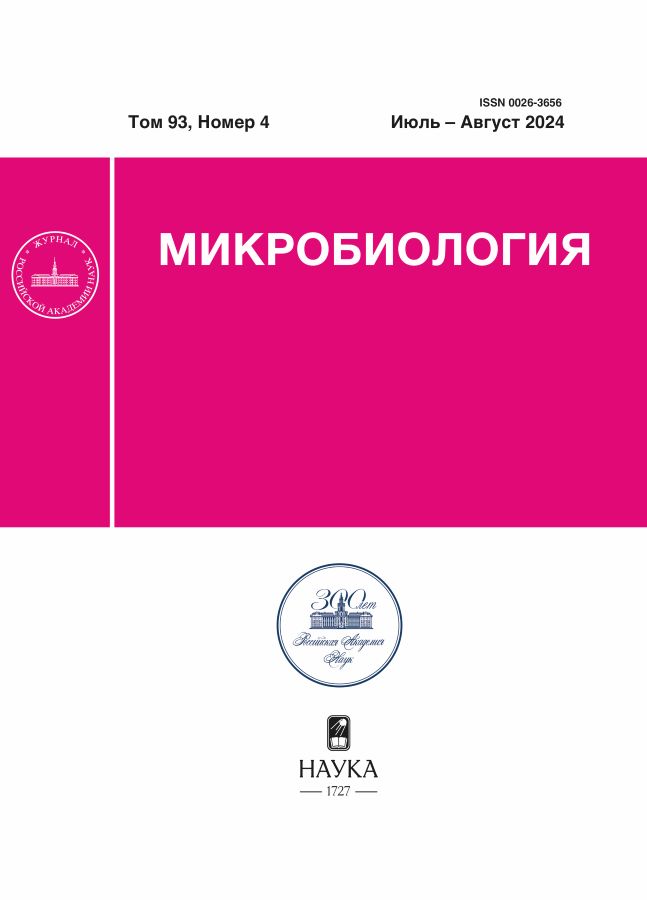Effect of Probiotic Lactobacteria on the Intestinal Microbiota and Morphological and Physiological Indicators of Quail
- 作者: Gavrilova E.A.1, Karaseva O.S.1, Monir Y.M.1, Ezhkova A.M.2, Ezhkov V.O.2, Volkov R.A.2, Senina A.M.1, Khusnutdinova D.R.1, Nikitina E.V.1,3, Yarullina D.R.1, Kayumov A.R.1
-
隶属关系:
- Kazan (Volga Region) Federal University
- Kazan State Academy of Veterinary Medicine named after N.E. Bauman
- Kazan National Research Technological University
- 期: 卷 93, 编号 4 (2024)
- 页面: 487-496
- 栏目: SHORT COMMUNICATIONS
- URL: https://snv63.ru/0026-3656/article/view/655100
- DOI: https://doi.org/10.31857/S0026365624040148
- ID: 655100
如何引用文章
详细
The work shows the effect of adding Lactiplantibacillus plantarum AG10 biomass to quail feed. Quails that received a probiotic feed additive for seven weeks showed a significant improvement in such economic indicators as the dynamics of live weight, gutted carcass weight and feed consumption per 1 kg of gain. Using the analysis of libraries of 16S rRNA gene sequences sequenced on the Illumina MiSeq platform, shifts in the microbiota of the cecum were discovered, which can help improve the morphological and physiological parameters of quails.
关键词
全文:
作者简介
E. Gavrilova
Kazan (Volga Region) Federal University
编辑信件的主要联系方式.
Email: Alalila@yandex.ru
俄罗斯联邦, Kazan, 420008
O. Karaseva
Kazan (Volga Region) Federal University
Email: Alalila@yandex.ru
俄罗斯联邦, Kazan, 420008
Y. Monir
Kazan (Volga Region) Federal University
Email: Alalila@yandex.ru
俄罗斯联邦, Kazan, 420008
A. Ezhkova
Kazan State Academy of Veterinary Medicine named after N.E. Bauman
Email: Alalila@yandex.ru
俄罗斯联邦, 420061, Kazan
V. Ezhkov
Kazan State Academy of Veterinary Medicine named after N.E. Bauman
Email: Alalila@yandex.ru
俄罗斯联邦, 420061, Kazan
R. Volkov
Kazan State Academy of Veterinary Medicine named after N.E. Bauman
Email: Alalila@yandex.ru
俄罗斯联邦, 420061, Kazan
A. Senina
Kazan (Volga Region) Federal University
Email: Alalila@yandex.ru
俄罗斯联邦, Kazan, 420008
D. Khusnutdinova
Kazan (Volga Region) Federal University
Email: Alalila@yandex.ru
俄罗斯联邦, Kazan, 420008
E. Nikitina
Kazan (Volga Region) Federal University; Kazan National Research Technological University
Email: Alalila@yandex.ru
俄罗斯联邦, Kazan, 420008; Kazan, 420015
D. Yarullina
Kazan (Volga Region) Federal University
Email: Alalila@yandex.ru
俄罗斯联邦, Kazan, 420008
A. Kayumov
Kazan (Volga Region) Federal University
Email: Alalila@yandex.ru
俄罗斯联邦, Kazan, 420008
参考
- Алиев М. Ш., Захаров В. П., Прокофьева Р. Г. Факторы повышения качества продукции и эффективности птицеводства в Республике Татарстан // Ученые записки Казанской государственной академии ветеринарной медицины им. Н. Э. Баумана. 2008. Т. 193. С. 12‒15.
- Полонский В. И., Сумина А. В. Влияние физических характеристик зернового сырья на функциональную ценность кормов для птиц // Вестн. Российского университета дружбы народов. Сер. Агрономия и животноводство. 2021. Т. 16. № 2. С. 167‒175.
- Путивская Т. Б., Норовяткин В. И. Проект повышения эффективности разведения перепелов // Региональные агросистемы: экономика и социология. 2022. № 3. С. 56‒62.
- Beck B. R., Park G. S., Jeong D. Y., Lee Y. H., Im S., Song W. H., Kang J. Multidisciplinary and comparative investigations of potential psychobiotic effects of Lactobacillus strains isolated from newborns and their impact on gut microbiota and ileal transcriptome in a healthy murine model // Front. Cell. Infect. Microbiol. 2019. V. 9. Art. 269.
- Campana R., van Hemert S., Baffone W. Strain-specific probiotic properties of lactic acid bacteria and their interference with human intestinal pathogens invasion // Gut Pathogens. 2017. V. 9. Art. 12.
- Gavrilova E., Anisimova E., Gabdelkhadieva A., Nikitina E., Vafina A., Yarullina D., Bogachev M., Kayumov A. Newly isolated lactic acid bacteria from silage targeting biofilms of foodborne pathogens during milk fermentation // BMC Microbiol. 2019. V. 19. P. 1‒12.
- Hill C., Guarner F., Reid G., Gibson G. R., Merenstein D. J., Pot B., Sanders M E. Expert consensus document. The International Scientific Association for Probiotics and Prebiotics consensus statement on the scope and appropriate use of the term probiotic // Nat. Rev. Gastroenterol. Hepatol. 2014. V. 11. P. 506–514.
- Jha R., Das R., Oak S., Mishra P. Probiotics (direct-fed microbials) in poultry nutrition and their effects on nutrient utilization, growth and laying performance, and gut health: a systematic review // Animals. 2020. V. 10. Art. 1863.
- Lozupone C., Lladser M. E., Knights D., Stombaugh J., Knight R. UniFrac: an effective distance metric for microbial community comparison // ISME J. 2011. V. 5. P. 169‒172.
- Park Y. H., Hamidon F., Rajangan C., Soh K. P., Gan C. Y., Lim T. S., Abdullah W. N.W., Liong M. T. Application of probiotics for the production of safe and high-quality poultry meat // Korean J. Food Sci. Animal Resour. 2016. V. 36. P. 567‒576.
- Pourtorabi E., Farzin F., Seraj A. Effects of genetic and non-genetic factors on body weight and carcass related traits in two strains of Japanese quails // Poultry Sci. J. 2017. V. 5. P. 17‒24.
- Stanley D., Hughes R. J., Geier M. S., Moore R. J. Bacteria within the gastrointestinal tract microbiota correlated with improved growth and feed conversion: challenges presented for the identification of performance enhancing probiotic bacteria // Front. Microbiol. 2016. V. 7. Art. 187.
- Stojanov S., Berlec A., Štrukelj B. The influence of probiotics on the Firmicutes/Bacteroidetes ratio in the treatment of obesity and inflammatory bowel disease // Microorganisms. 2020. V. 8. Art. 1715.
- Tolnai E., Fauszt P., Fidler G., Pesti-Asboth G., Szilagyi E., Stagel A., Paholcsek M. Nutraceuticals induced changes in the broiler gastrointestinal tract microbiota // MSystems. 2021. V. 6. Art. e01124-20.
- Wilkinson N., Hughes R. J., Aspden W. J., Chapman J., Moore R. J., Stanley D. The gastrointestinal tract microbiota of the Japanese quail, Coturnix japonica // Appl. Microbiol. Biotechnol. 2016. V. 100. P. 4201‒4209.
- Zaefarian F., Abdollahi M. R., Cowieson A., Ravindran V. Avian liver: the forgotten organ // Animals (Basel). 2019. V. 9. Art. 63.
补充文件













